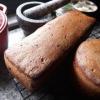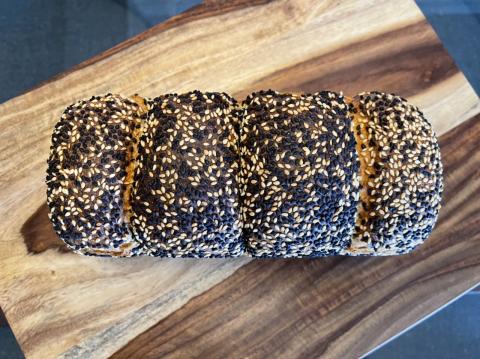Last year Rus Brot posted a series of videos in an attempt to reproduce and demonstrate how bread was, or at least could have been baked, "in the old times" in Russian villages: https://youtu.be/meVg13NtnPw. "Yeast-less" refers to a fad in Russia about how using commercial yeast is bad for you, and sourdough bread is marketed as "yeast-less", which is of course absurd (and he's made fun of this multiple times on his channel). For a long time I couldn't be bothered to try following these instructions, except for using his proposed way of creating a liquid rye sourdough starter ("kvass"). That worked exceptionally well for me back in Moscow, to create a very strong starter within two days.
Now that I am sort of settled here in Basel and got all my equipment including the heating pad for temperature control, I finally decided to try and follow all instructions from the start (create a new starter again) and actually bake some bread with that technology. It did seem interesting: instead of maintaining the starter, a little portion of mature dough is dried by rubbing 1:1 with flour to preserve for a long time. Then this dry starter crumbs are used to inoculate a liquid starter "kvass", which is used for pre-dough and dough. And again a small portion of the dough is dried up for the future.
Unfortunately, for some reason, my attempt to make the starter here didn't work out, my suspicion is the water I used was too hot (normally for refreshing a starter this temperature would have been perfectly fine, but perhaps to start a new one it was too much). To be on the safe side in case actually it was the flour, when repeating I used rye schrot mixed with barley malt instead of whole rye flour, and some raisins, and then everything went perfectly.
Bread Nr 1
The first bread he recommends baking is 100% whole rye. Which I did. On the outside it looked great!

And it tasted nice too, just simple robust whole grain rye. But it had these weird cracks inside, I've never seen this before, very curious where it could have come from...

The bread was huge (from 1 kg flour), and quite dense, so best eaten in thin slices, so it's been three weeks and I still haven't finished it, since I am temporarily here on my own. While it's a bit dry on the outside under the crust now and hard to cut, inside it's still moist, and no signs of any mold are visible. Today toasted some small peaces in olive oil with salt, pepper and garlic powder, they were great as croutons in a salad.
Bread Nr 2
Now after almost three weeks of no bread baking I was bored and although I still haven't finished this bread, I decided to bake the next bread following his instructions. Dry dough is resuspended in warm water with flour and malt extract, and left to ferment for 20-24 hours at 25-26C. I mixed it in the morning before work, and when I came back home the starter was already bubbly and frothy - but not at all sour yet. So I just stirred it vigorously, and then once more before bed. Then it had a bit of acidity and more complex smell. In the morning about 23 hrs later it must have overfermented, because there were no bubbles at all! Must have consumed all the food and gone quiet.
I assumed the yeast and bacteria were all still there, and just proceeded with the pre-dough (5.5 hrs at 28-29C - I gave it extra 30-40 min to account for the sleepy starter, and also I tend to like a touch more sour bread than his default recipes), and the final dough (1.5 hrs at 30C), shaping and final proof. Like in the video I used some high extraction wheat flour in this recipe (I used ~17% Ruchmehl, in place of his 15% grade 2 flour). The dough was very pleasant to work with, easy to shape and I had a good feeling about it - the only second thought I had was it didn't seem quite as airy as . I final proofed for 40-45 min above a tray of hot water, air temperature was around 35C. Then applied liquid dough, docked and baked - all just like in the video. Just this time I split the dough into to loaves, planning to give one away, so I don't end up eating it all again on my own for three weeks.
The loaves looked good, the only thing they had these back spots, which from experience I know show bubbles just under the crust. But what does the presence of these bubbles mean about the dough? I don't know.

Then net day (today) I cut into one of the loaves. And was greeted with this crumb:

Had it been a wheat bread, I would have assumed it was underfermented, with denser areas between large holes. But I've never seen anything like that in rye bread! Would one expect the same crumb structure defect from underfermentation? Or is that another issue? The crumb is not sticky, and not crumbly, can be cut with a serrated bread knife without leaving any marks on it. But the caverns are a clear issue... Tastes good - just like I remember simple mostly rye bread tasting in Russia. Nothing too special, just sturdy with a prominent taste.
Curious what other might think about the issues with these breads, and what could have caused cracks in the first bread, or caverns in the crumb in the second bread.


























